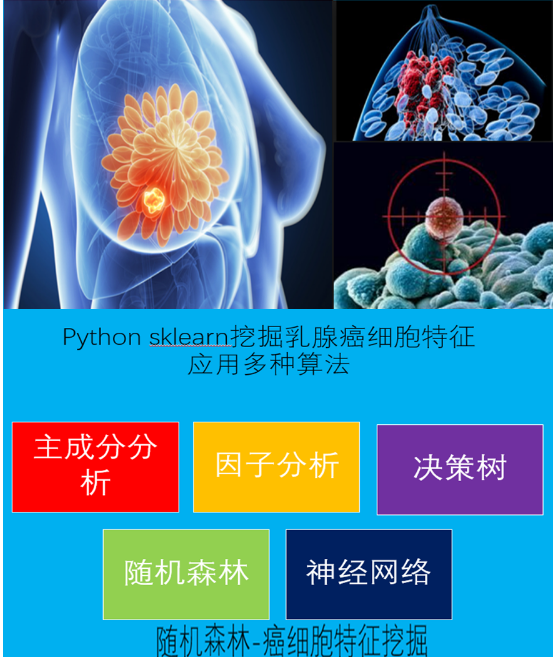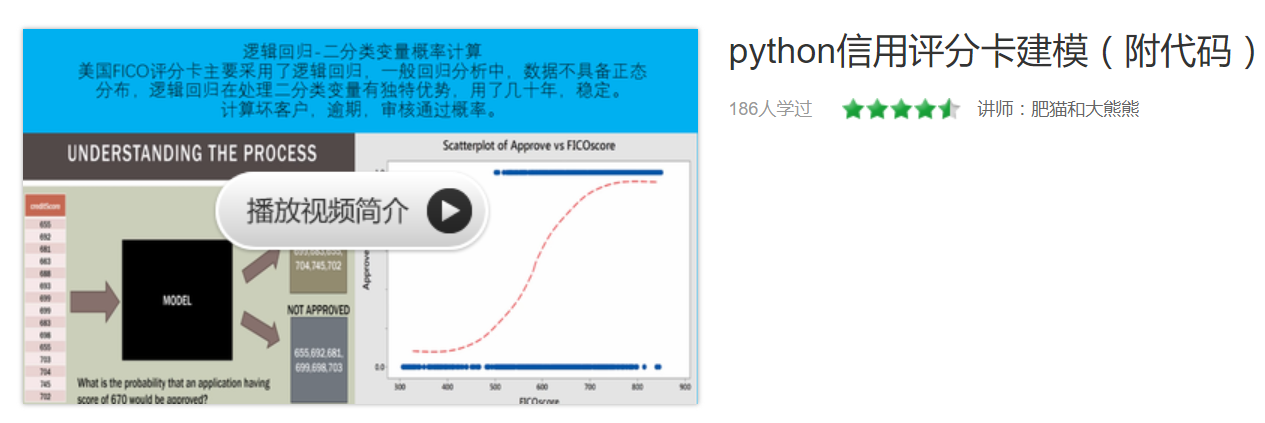python机器学习-乳腺癌细胞挖掘(博主亲自录制视频)
项目合作QQ:231469242
多重共线性测试需要改进
文件夹需要两个包


python3.0 anaconda
normality_check.py 正太检验
# -*- coding: utf-8 -*-
'''
Author:Toby
QQ:231469242,all right reversed,no commercial use
normality_check.py
正态性检验脚本
'''
import scipy
from scipy.stats import f
import numpy as np
import matplotlib.pyplot as plt
import scipy.stats as stats
# additional packages
from statsmodels.stats.diagnostic import lillifors
#正态分布测试
def check_normality(testData):
#20<样本数<50用normal test算法检验正态分布性
if 20<len(testData) <50:
p_value= stats.normaltest(testData)[1]
if p_value<0.05:
print("use normaltest")
print ("data are not normal distributed")
return False
else:
print("use normaltest")
print ("data are normal distributed")
return True
#样本数小于50用Shapiro-Wilk算法检验正态分布性
if len(testData) <50:
p_value= stats.shapiro(testData)[1]
if p_value<0.05:
print ("use shapiro:")
print ("data are not normal distributed")
return False
else:
print ("use shapiro:")
print ("data are normal distributed")
return True
if 300>=len(testData) >=50:
p_value= lillifors(testData)[1]
if p_value<0.05:
print ("use lillifors:")
print ("data are not normal distributed")
return False
else:
print ("use lillifors:")
print ("data are normal distributed")
return True
if len(testData) >300:
p_value= stats.kstest(testData,'norm')[1]
if p_value<0.05:
print ("use kstest:")
print ("data are not normal distributed")
return False
else:
print ("use kstest:")
print ("data are normal distributed")
return True
#对所有样本组进行正态性检验
def NormalTest(list_groups):
for group in list_groups:
#正态性检验
status=check_normality(group)
if status==False :
return False
return True
Rsquare_multimode.py 多种模型计算R平方
加入了线性显著检测和r相关系数显著检测,多重共线性,自相关,残差正太检验等等
# -*- coding: utf-8 -*-
#斯皮尔曼等级相关(Spearman’s correlation coefficient for ranked data)
import math,pylab,scipy
import numpy as np
import scipy.stats as stats
from scipy.stats import t
from scipy.stats import f
import pandas as pd
import matplotlib.pyplot as plt
from statsmodels.stats.diagnostic import lillifors
import normality_check
import statsmodels.formula.api as sm
x=[4.03,3.76,3.77,3.34,3.47,2.92,3.20,2.71,3.53,4.51]
y=[6.47,6.13,6.19,4.89,5.63,4.52,5.89,4.79,5.27,6.08]
list_group=[x,y]
sample=len(x)
#显著性
a=0.05
#数据可视化
plt.plot(x,y,'ro')
#斯皮尔曼等级相关,非参数检验
def Spearmanr(x,y):
print("use spearmanr,Nonparametric tests")
#样本不一致时,发出警告
if len(x)!=len(y):
print ("warming,the samples are not equal!")
r,p=stats.spearmanr(x,y)
print("spearman r**2:",r**2)
print("spearman p:",p)
if sample<500 and p>0.05:
print("when sample < 500,p has no mean(>0.05)")
print("when sample > 500,p has mean")
#皮尔森 ,参数检验
def Pearsonr(x,y):
print("use Pearson,parametric tests")
r,p=stats.pearsonr(x,y)
print("pearson r**2:",r**2)
print("pearson p:",p)
if sample<30:
print("when sample <30,pearson has no mean")
#皮尔森 ,参数检验,带有详细参数
def Pearsonr_details(x,y,xLabel,yLabel,formula):
n=len(x)
df=n-2
data=pd.DataFrame({yLabel:y,xLabel:x})
result = sm.ols(formula, data).fit()
print(result.summary())
#模型F分布显著性分析
print('
')
print("linear relation Significant test:...................................")
#如果F检验的P值<0.05,拒绝H0,x和y无显著关系,H1成立,x和y有显著关系
if result.f_pvalue<0.05:
print ("P value of f test<0.05,the linear relation is right.")
#R的显著检验
print('
')
print("R significant test:...................................")
r_square=result.rsquared
r=math.sqrt(r_square)
t_score=r*math.sqrt(n-2)/(math.sqrt(1-r**2))
t_std=t.isf(a/2,df)
if t_score<-t_std or t_score>t_std:
print ("R is significant according to its sample size")
else:
print ("R is not significant")
#残差分析
print('
')
print("residual error analysis:...................................")
states=normality_check.check_normality(result.resid)
if states==True:
print("the residual error are normal distributed")
else:
print("the residual error are not normal distributed")
#残差偏态和峰态
Skew = stats.skew(result.resid, bias=True)
Kurtosis = stats.kurtosis(result.resid, fisher=False,bias=True)
if round(Skew,1)==0:
print("residual errors normality Skew:in middle,perfect match")
elif round(Skew,1)>0:
print("residual errors normality Skew:close right")
elif round(Skew,1)<0:
print("residual errors normality Skew:close left")
if round(Kurtosis,1)==3:
print("residual errors normality Kurtosis:in middle,perfect match")
elif round(Kurtosis,1)>3:
print("residual errors normality Kurtosis:more peak")
elif round(Kurtosis,1)<3:
print("residual errors normality Kurtosis:more flat")
#自相关分析autocorrelation
print('
')
print("autocorrelation test:...................................")
DW = np.sum( np.diff( result.resid.values )**2.0 )/ result.ssr
if round(DW,1)==2:
print("Durbin-Watson close to 2,there is no autocorrelation.OLS model works well")
#共线性检查
print('
')
print("multicollinearity test:")
conditionNumber=result.condition_number
if conditionNumber>30:
print("conditionNumber>30,multicollinearity exists")
else:
print("conditionNumber<=30,multicollinearity not exists")
#绘制残差图,用于方差齐性检验
Draw_residual(list(result.resid))
'''
result.rsquared
Out[28]: 0.61510660055413524
'''
#kendalltau非参数检验
def Kendalltau(x,y):
print("use kendalltau,Nonparametric tests")
r,p=stats.kendalltau(x,y)
print("kendalltau r**2:",r**2)
print("kendalltau p:",p)
#选择模型
def R_mode(x,y,xLabel,yLabel,formula):
#正态性检验
Normal_result=normality_check.NormalTest(list_group)
print ("normality result:",Normal_result)
if len(list_group)>2:
Kendalltau(x,y)
if Normal_result==False:
Spearmanr(x,y)
Kendalltau(x,y)
if Normal_result==True:
Pearsonr_details(x,y,xLabel,yLabel,formula)
#调整的R方
def Adjust_Rsquare(r_square,n,k):
adjust_rSquare=1-((1-r_square)*(n-1)*1.0/(n-k-1))
return adjust_rSquare
'''
n=len(x)
n=10
k=1
r_square=0.615
Adjust_Rsquare(r_square,n,k)
Out[11]: 0.566875
'''
#绘图
def Plot(x,y,yLabel,xLabel,Title):
plt.plot(x,y,'ro')
plt.ylabel(yLabel)
plt.xlabel(xLabel)
plt.title(Title)
plt.show()
#绘图参数
yLabel='Alcohol'
xLabel='Tobacco'
Title='Sales in Several UK Regions'
Plot(x,y,yLabel,xLabel,Title)
formula='Alcohol ~ Tobacco'
#绘制残点图
def Draw_residual(residual_list):
x=[i for i in range(1,len(residual_list)+1)]
y=residual_list
pylab.plot(x,y,'ro')
pylab.title("draw residual to check wrong number")
# Pad margins so that markers don't get clipped by the axes,让点不与坐标轴重合
pylab.margins(0.3)
#绘制网格
pylab.grid(True)
pylab.show()
R_mode(x,y,xLabel,yLabel,formula)
'''
result.fittedvalues表示预测的y值阵列
result.fittedvalues
Out[42]:
0 6.094983
1 5.823391
2 5.833450
3 5.400915
4 5.531682
5 4.978439
6 5.260090
7 4.767201
8 5.592035
9 6.577813
dtype: float64
#计算残差的偏态
S = stats.skew(result.resid, bias=True)
Out[44]: -0.013678125910039975
K = stats.kurtosis(result.resid, fisher=False,bias=True)
K
Out[47]: 1.5271300905736027
'''
result.params 得到两个参数:x的系数和截距
截距
result.params[0]
x系数
result.params[1]




dubin watson解读
--残差是否符合正太分布
D.W统计量是用来检验残差分布是否为正态分布的,因为用OLS进行回归估计是假设模型残差服从正态分布的,因此,如果残差不服从正态分布,那么,模型将是有偏的,也就是说模型的解释能力是不强的。
D.W统计量在2左右说明残差是服从正态分布的,若偏离2太远,那么你所构建的模型
的解释能力就要受影响了。
jarque-bera解读
----样本是否符合正太分布
JB统计量全称叫Jarque-Bera统计量,是用来检验一组样本是否能够认为来自正态总体的一种方法,它依据OLS残差,对大样本进行检验(或称为渐进检验)。
Jarque和Bera建立了如下检验统计量——JB统计量:
若变量服从正态分布,则S为零,K为3,因而JB统计量的值为零;如果变量不是正态变量,则JB统计量将为一个逐渐增大值。
如果JB统计量值较大,比如为11,则可以计算出卡方值大于11的概率为0.004,这个概率过小,因此不能认为样本来自正态分布。反之,成立。
Jarque-Bera的P值接近于0,表明显著性高,数据服从正态分布。
Omnibus解读
Omnibus统计量的P值都接近于0,自变量的作用显著。
Omnibus tests are a kind of statistical test. They test whether the explained variance in a set of data is significantly greater than the unexplained variance, overall. One example is the F-test in the analysis of variance. There can be legitimate significant effects within a model even if the omnibus test is not significant. For instance, in a model with two independent variables, if only one variable exerts a significant effect on the dependent variable and the other does not, then the omnibus test may be non-significant. This fact does not affect the conclusions that may be drawn from the one significant variable. In order to test effects within an omnibus test, researchers often use contrasts.
https://en.wikipedia.org/wiki/Omnibus_test



